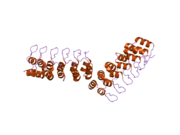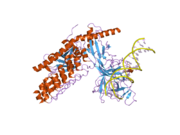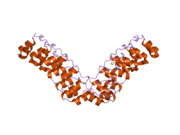Neurogenic locus notch homolog protein 1 (Notch 1) is a protein encoded in humans by the NOTCH1 gene.[5] Notch 1 is a single-pass transmembrane receptor.
YouTube Encyclopedic
-
1/5Views:67 70327 4823017302 235
-
Mechanism of NOTCH SIGNALING PATHWAY
-
Top Notch TV 1. Unit 1. Introduce Me. Scene 1. Subtitled
-
Top Notch 1 - Unit 8 - Sitcom Scene 1:Which dress do you like better?
-
NOTCH1: The Clinical and Basic Science Behind it
-
Top Notch Fundamentals 3rd EDITION - Units 1-7 REVIEW
Transcription
Function
This gene encodes a member of the Notch family. Members of this type 1 transmembrane protein family share structural characteristics including an extracellular domain consisting of multiple epidermal growth factor-like (EGF) repeats, and an intracellular domain consisting of multiple, different domain types. Notch family members play a role in a variety of developmental processes by controlling cell fate decisions. The Notch signaling network is an evolutionarily conserved intercellular signaling pathway that regulates interactions between physically adjacent cells. In Drosophila, notch interaction with its cell-bound ligands (delta, serrate) establishes an intercellular signaling pathway that plays a key role in development. Homologues of the notch-ligands have also been identified in humans, but precise interactions between these ligands and the human notch homologues remain to be determined. This protein is cleaved in the trans-Golgi network, and presented on the cell surface as a heterodimer. This protein functions as a receptor for membrane bound ligands, and may play multiple roles during development.[6]
A deficiency can be associated with bicuspid aortic valve.[7]
There is evidence that activated Notch 1 and Notch 3 promote differentiation of progenitor cells into astroglia.[8] Notch 1, when activated before birth, induces radial glia differentiation,[9] but postnatally induces the differentiation into astrocytes.[10] One study shows that Notch-1 cascade is activated by Reelin in an unidentified way.[11] Reelin and Notch1 cooperate in the development of the dentate gyrus, according to another.[12]
Interactions
NOTCH1 has been shown to interact with:
References
- ^ a b c GRCh38: Ensembl release 89: ENSG00000148400 - Ensembl, May 2017
- ^ a b c GRCm38: Ensembl release 89: ENSMUSG00000026923 - Ensembl, May 2017
- ^ "Human PubMed Reference:". National Center for Biotechnology Information, U.S. National Library of Medicine.
- ^ "Mouse PubMed Reference:". National Center for Biotechnology Information, U.S. National Library of Medicine.
- ^ "NOTCH1 - Neurogenic locus notch homolog protein 1 precursor - Homo sapiens (Human) - NOTCH1 gene & protein". www.uniprot.org. Retrieved 23 May 2022.
- ^ "Entrez Gene: NOTCH1 Notch homolog 1, translocation-associated (Drosophila)".
- ^ McKellar SH, Tester DJ, Yagubyan M, Majumdar R, Ackerman MJ, Sundt TM (August 2007). "Novel NOTCH1 mutations in patients with bicuspid aortic valve disease and thoracic aortic aneurysms". J Thorac Cardiovasc Surg. 134 (2): 290–296. doi:10.1016/j.jtcvs.2007.02.041. PMID 17662764.
- ^ Tanigaki K, Nogaki F, Takahashi J, Tashiro K, Kurooka H, Honjo T (January 2001). "Notch1 and Notch3 instructively restrict bFGF-responsive multipotent neural progenitor cells to an astroglial fate". Neuron. 29 (1): 45–55. doi:10.1016/S0896-6273(01)00179-9. hdl:2433/150564. PMID 11182080. S2CID 17047028.
- ^ Gaiano N, Nye JS, Fishell G (May 2000). "Radial glial identity is promoted by Notch1 signaling in the murine forebrain". Neuron. 26 (2): 395–404. doi:10.1016/S0896-6273(00)81172-1. PMID 10839358. S2CID 15861936.
- ^ Chambers CB, Peng Y, Nguyen H, Gaiano N, Fishell G, Nye JS (March 2001). "Spatiotemporal selectivity of response to Notch1 signals in mammalian forebrain precursors". Development. 128 (5): 689–702. doi:10.1242/dev.128.5.689. PMID 11171394.
- ^ Keilani S, Sugaya K (July 2008). "Reelin induces a radial glial phenotype in human neural progenitor cells by activation of Notch-1". BMC Dev. Biol. 8 (1): 69. doi:10.1186/1471-213X-8-69. PMC 2447831. PMID 18593473.
- ^ Sibbe M, Förster E, Basak O, Taylor V, Frotscher M (July 2009). "Reelin and Notch1 cooperate in the development of the dentate gyrus". J. Neurosci. 29 (26): 8578–85. doi:10.1523/JNEUROSCI.0958-09.2009. PMC 6665659. PMID 19571148.
- ^ Foltz DR, Santiago MC, Berechid BE, Nye JS (June 2002). "Glycogen synthase kinase-3beta modulates notch signaling and stability". Curr. Biol. 12 (12): 1006–11. Bibcode:2002CBio...12.1006F. doi:10.1016/s0960-9822(02)00888-6. PMID 12123574. S2CID 15884556.
- ^ Sade H, Krishna S, Sarin A (January 2004). "The anti-apoptotic effect of Notch-1 requires p56lck-dependent, Akt/PKB-mediated signaling in T cells". J. Biol. Chem. 279 (4): 2937–44. doi:10.1074/jbc.M309924200. PMID 14583609. S2CID 42454311.
- ^ Wu L, Aster JC, Blacklow SC, Lake R, Artavanis-Tsakonas S, Griffin JD (December 2000). "MAML1, a human homologue of Drosophila mastermind, is a transcriptional co-activator for NOTCH receptors". Nat. Genet. 26 (4): 484–9. doi:10.1038/82644. PMID 11101851. S2CID 23335042.
- ^ Wu L, Sun T, Kobayashi K, Gao P, Griffin JD (November 2002). "Identification of a family of mastermind-like transcriptional coactivators for mammalian notch receptors". Mol. Cell. Biol. 22 (21): 7688–700. doi:10.1128/mcb.22.21.7688-7700.2002. PMC 135662. PMID 12370315.
- ^ Blokzijl A, Dahlqvist C, Reissmann E, Falk A, Moliner A, Lendahl U, Ibáñez CF (November 2003). "Cross-talk between the Notch and TGF-beta signaling pathways mediated by interaction of the Notch intracellular domain with Smad3". J. Cell Biol. 163 (4): 723–8. doi:10.1083/jcb.200305112. PMC 2173673. PMID 14638857.
- ^ Guan E, Wang J, Laborda J, Norcross M, Baeuerle PA, Hoffman T (May 1996). "T cell leukemia-associated human Notch/translocation-associated Notch homologue has I kappa B-like activity and physically interacts with nuclear factor-kappa B proteins in T cells". J. Exp. Med. 183 (5): 2025–32. doi:10.1084/jem.183.5.2025. PMC 2192574. PMID 8642313.
- ^ Wang J, Shelly L, Miele L, Boykins R, Norcross MA, Guan E (July 2001). "Human Notch-1 inhibits NF-kappa B activity in the nucleus through a direct interaction involving a novel domain". J. Immunol. 167 (1): 289–95. doi:10.4049/jimmunol.167.1.289. PMID 11418662. S2CID 22399328.
- ^ Sakamoto K, Yamaguchi S, Ando R, Miyawaki A, Kabasawa Y, Takagi M, Li CL, Perbal B, Katsube K (August 2002). "The nephroblastoma overexpressed gene (NOV/ccn3) protein associates with Notch1 extracellular domain and inhibits myoblast differentiation via Notch signaling pathway". J. Biol. Chem. 277 (33): 29399–405. doi:10.1074/jbc.M203727200. PMID 12050162. S2CID 26465428.
- ^ Nam Y, Weng AP, Aster JC, Blacklow SC (June 2003). "Structural requirements for assembly of the CSL.intracellular Notch1.Mastermind-like 1 transcriptional activation complex". J. Biol. Chem. 278 (23): 21232–9. doi:10.1074/jbc.M301567200. PMID 12644465. S2CID 13637961.
- ^ Aster JC, Robertson ES, Hasserjian RP, Turner JR, Kieff E, Sklar J (April 1997). "Oncogenic forms of NOTCH1 lacking either the primary binding site for RBP-Jkappa or nuclear localization sequences retain the ability to associate with RBP-Jkappa and activate transcription". J. Biol. Chem. 272 (17): 11336–43. doi:10.1074/jbc.272.17.11336. PMID 9111040. S2CID 36236215.
- ^ Beatus P, Lundkvist J, Oberg C, Pedersen K, Lendahl U (June 2001). "The origin of the ankyrin repeat region in Notch intracellular domains is critical for regulation of HES promoter activity". Mech. Dev. 104 (1–2): 3–20. doi:10.1016/s0925-4773(01)00373-2. PMID 11404076. S2CID 9526831.
- ^ Zhou S, Fujimuro M, Hsieh JJ, Chen L, Miyamoto A, Weinmaster G, Hayward SD (April 2000). "SKIP, a CBF1-associated protein, interacts with the ankyrin repeat domain of NotchIC To facilitate NotchIC function". Mol. Cell. Biol. 20 (7): 2400–10. doi:10.1128/mcb.20.7.2400-2410.2000. PMC 85419. PMID 10713164.
- ^ Chastagner P, Israël A, Brou C (2008). "AIP4/Itch regulates Notch receptor degradation in the absence of ligand". PLOS ONE. 3 (7): e2735. Bibcode:2008PLoSO...3.2735C. doi:10.1371/journal.pone.0002735. PMC 2444042. PMID 18628966.
- ^ Yeh TS, Lin YM, Hsieh RH, Tseng MJ (October 2003). "Association of transcription factor YY1 with the high molecular weight Notch complex suppresses the transactivation activity of Notch". J. Biol. Chem. 278 (43): 41963–9. doi:10.1074/jbc.M304353200. PMID 12913000. S2CID 23574059.
- ^ Lim R, Sugino T, Nolte H, Andrade J, Zimmermann B, Shi C, Doddaballapur A, Ong YT, Wilhelm K, Fasse JW, Ernst A, Kaulich M, Husnjak K, Boettger T, Guenther S, Braun T, Krüger M, Benedito R, Dikic I, Potente M (April 2019). "Deubiquitinase USP10 regulates Notch signaling in the endothelium". Science. 364 (6436): 188–193. Bibcode:2019Sci...364..188L. doi:10.1126/science.aat0778. hdl:20.500.12105/9685. PMID 30975888. S2CID 109940358.
Further reading
- Artavanis-Tsakonas S, Rand MD, Lake RJ (1999). "Notch signaling: cell fate control and signal integration in development". Science. 284 (5415): 770–6. Bibcode:1999Sci...284..770A. doi:10.1126/science.284.5415.770. PMID 10221902.
- Mumm JS, Kopan R (2001). "Notch signaling: from the outside in". Dev. Biol. 228 (2): 151–65. doi:10.1006/dbio.2000.9960. PMID 11112321.
- Allenspach EJ, Maillard I, Aster JC, Pear WS (2003). "Notch signaling in cancer". Cancer Biol. Ther. 1 (5): 466–76. doi:10.4161/cbt.1.5.159. PMID 12496471. S2CID 1328739.
- Aster JC (2006). "Deregulated NOTCH signaling in acute T-cell lymphoblastic leukemia/lymphoma: new insights, questions, and opportunities". Int. J. Hematol. 82 (4): 295–301. doi:10.1532/IJH97.05096. PMID 16298817. S2CID 32528011.
External links
- NOTCH1+protein,+human at the U.S. National Library of Medicine Medical Subject Headings (MeSH)
- NOTCH1













